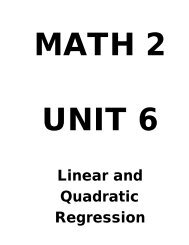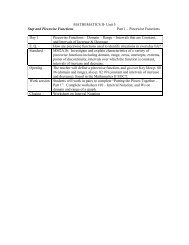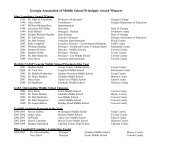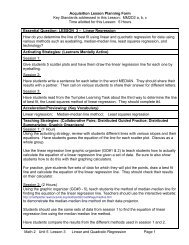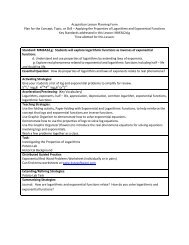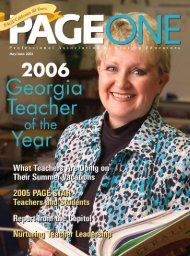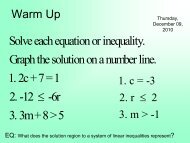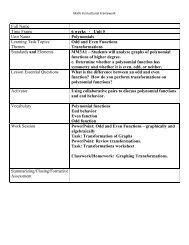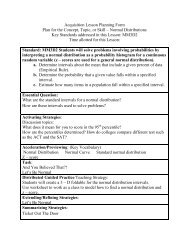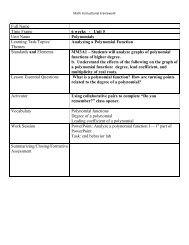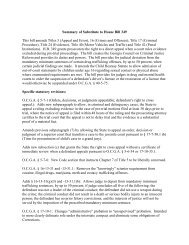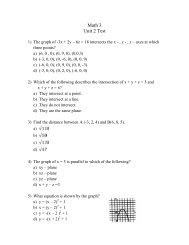Observation Rubric - Ciclt.net
Observation Rubric - Ciclt.net
Observation Rubric - Ciclt.net
You also want an ePaper? Increase the reach of your titles
YUMPU automatically turns print PDFs into web optimized ePapers that Google loves.
MRESA K – 5 Mathematics Endorsement <strong>Observation</strong> <strong>Rubric</strong><br />
Teaching and Learning in the Mathematics Classroom/(Addendum to the Standards-Based Classroom <strong>Rubric</strong>)<br />
Adapted from GaDOE Standards-Based Classroom <strong>Rubric</strong><br />
(This rubric is an extension to the Standards-Based Classroom <strong>Rubric</strong> and details further concepts specific to the mathematics classroom. This rubric for mathematics standardsbased<br />
classrooms is an implementation rubric and each column builds on the previous column.)<br />
Name_____________________________________ Grade Level ________ Date __________ Time __________ Setting_________________<br />
Concept Not Evident Emerging Proficient Exemplary – All must be evident<br />
Teaching and<br />
learning reflects a<br />
balance of skills,<br />
conceptual<br />
understanding, and<br />
problem solving.<br />
Instruction is<br />
predominantly skillsdriven<br />
by the textbook<br />
and worksheets.<br />
OR<br />
The teacher assigns<br />
large numbers of<br />
repetitive, skills-based<br />
problems.<br />
OR<br />
Students work<br />
independently.<br />
Instruction is driven by the<br />
textbook and worksheets,<br />
and includes not only<br />
isolated skills, but the<br />
application of isolated<br />
skills in solving problems.<br />
OR<br />
Students learn an isolated<br />
skill and then apply that<br />
skill to solve mathematical<br />
problems as well as word<br />
problems.<br />
The teacher provides<br />
opportunities for new skills and<br />
concepts to be learned within the<br />
context of real-world situations.<br />
Students are engaged in task(s)<br />
related to the GPS that<br />
incorporate the use of skills,<br />
conceptual understanding, and<br />
problem solving.<br />
The teacher models simple task(s),<br />
establishes expectations, and identifies<br />
important vocabulary before students engage<br />
in a task.<br />
AND<br />
The teacher supports students as they work<br />
through challenging task(s) without taking<br />
over the process of thinking for them.<br />
AND<br />
Students are engaged in task(s) that develop<br />
mathematical concepts and skills, require<br />
students to make connections, involve<br />
problem solving, and encourage mathematical<br />
reasoning.<br />
AND<br />
Students can explain why a mathematical<br />
idea is important and the kinds of contexts in<br />
which it is useful.<br />
AND<br />
Opportunities are provided for students who<br />
solve the problem differently from others to<br />
share their procedures, thus encouraging<br />
diverse thinking.<br />
AND<br />
The teacher uses the closing of a lesson to<br />
have students summarize the main points of<br />
the task and identify rules or hypotheses. The<br />
teachers clarifies misconceptions, uses<br />
questions to probe for deeper understanding.<br />
1
Concept Not Evident Emerging Proficient Exemplary<br />
Manipulatives are<br />
used appropriately.<br />
Manipulatives are<br />
stored in a central<br />
location in the<br />
building.<br />
OR<br />
Manipulatives are used<br />
as toys or not used at<br />
all.<br />
Manipulatives are visible<br />
in the classroom, but not<br />
readily accessible to<br />
students.<br />
OR<br />
The teacher models use of<br />
manipulatives and directs<br />
student use of<br />
manipulatives.<br />
OR<br />
Students use manipulatives<br />
at the same time, in the<br />
same way.<br />
OR<br />
Students imitate use of<br />
manipulatives without<br />
reflection, exploration, or<br />
connection to symbols,<br />
pictures, and explanations.<br />
The teacher actively engages<br />
students in using manipulatives<br />
to construct and give meaning to<br />
new concepts.<br />
AND<br />
Students use manipulatives to<br />
make connections from symbols,<br />
pictures, and explanations to<br />
concepts in order to problem<br />
solve.<br />
Students independently select appropriate<br />
manipulatives to enable them to represent and<br />
assess their understanding of mathematics.<br />
OR<br />
Students can demonstrate their knowledge of<br />
abstract relationships using symbols, pictures,<br />
and explanations, but are no longer dependent<br />
on manipulatives.<br />
OR<br />
Students have internalized use of<br />
manipulatives and can describe how<br />
manipulatives were used to develop<br />
understanding of mathematics.<br />
Students will<br />
solve a variety of<br />
real-world<br />
problems.<br />
The teacher only<br />
assigns skill-based<br />
problems.<br />
OR<br />
Students are not able to<br />
comprehend, reason,<br />
and/or solve problems.<br />
The teacher assigns word<br />
problems that require<br />
simple calculations related<br />
to an isolated skill.<br />
OR<br />
The teacher limits the<br />
method by which students<br />
may solve problems.<br />
OR<br />
The teacher presents<br />
problem solving strategies<br />
in isolation.<br />
The teacher models a variety of<br />
strategies to solve problems.<br />
AND<br />
The teacher presents rigorous<br />
and relevant problems in<br />
mathematics.<br />
AND<br />
Students model and solve<br />
rigorous and relevant problems<br />
using appropriate strategies.<br />
The teacher provides students with<br />
opportunities to engage in performance task(s<br />
that allow students to discover new<br />
mathematical knowledge through problem<br />
solving.<br />
AND<br />
Students apply their mathematical<br />
understanding to solve real world problems.<br />
AND<br />
Students apply and adapt appropriate<br />
strategies to solve problems.<br />
AND<br />
Students communicate their process of<br />
mathematical problem solving.<br />
2
Concept Not Evident Emerging Proficient Exemplary<br />
Students will<br />
justify their<br />
reasoning and<br />
evaluate<br />
mathematical<br />
arguments of<br />
others.<br />
The teacher does not<br />
ask students to justify<br />
their answers.<br />
Answers are simply<br />
right or wrong.<br />
OR<br />
Students have limited<br />
or no knowledge of<br />
how to evaluate<br />
mathematical<br />
arguments.<br />
The teacher arrives at an<br />
answer, explains why,<br />
tells how, and details<br />
ideas to justify<br />
reasoning.<br />
OR<br />
Students are able to<br />
explain the process used<br />
to arrive at an answer,<br />
but are unable to explain<br />
why.<br />
The teacher uses various types<br />
of reasoning (inductive,<br />
deductive, counter-examples,<br />
etc. appropriate to grade<br />
level) and methods of proofs<br />
(paper folding, miras, etc.)<br />
when introducing a concept.<br />
AND<br />
Students are able to arrive at<br />
an answer and justify their<br />
reasoning by explaining why<br />
and telling how.<br />
Students make and investigate<br />
mathematical conjectures (mathematical<br />
statements that appear to be true, but not<br />
formally proven) about solutions to<br />
problems.<br />
OR<br />
Students evaluate their own mathematical<br />
arguments as well as those of others.<br />
Students offer various methods of proof<br />
to support their positions.<br />
Students will<br />
communicate<br />
mathematically.<br />
The teacher does not<br />
require students to<br />
justify their answers.<br />
OR<br />
Students provide<br />
answers only and do<br />
not explain their<br />
mathematical<br />
thinking orally or in<br />
writing.<br />
The teacher accepts<br />
explanations that do not<br />
include grade level<br />
appropriate<br />
mathematical language<br />
or the language of the<br />
standards.<br />
OR<br />
Students can explain<br />
their thinking and<br />
learning, but do not use<br />
mathematical language<br />
or the language of the<br />
standards.<br />
The teacher models and<br />
expects students to use<br />
appropriate grade level<br />
mathematical language and<br />
the language of the standards<br />
when communicating<br />
mathematical reasoning.<br />
AND<br />
Students use mathematical<br />
language and the language of<br />
the standards to clearly<br />
communicate their<br />
mathematical thinking to<br />
others when prompted.<br />
The teacher provides students<br />
opportunities to engage in conversation,<br />
discussion, and debate using<br />
mathematical language and the language<br />
of the standards when communicating<br />
mathematical reasoning.<br />
AND<br />
Students use mathematical language and<br />
the language of the standards to<br />
communicate their mathematical thinking<br />
and ideas coherently and precisely to<br />
peers, teachers, and others.<br />
3
Concept Not Evident Emerging Proficient Exemplary<br />
Students will<br />
make connections<br />
among<br />
mathematical<br />
ideas and to other<br />
disciplines.<br />
Mathematical skills<br />
and concepts are<br />
taught in isolation.<br />
Students do not<br />
connect new<br />
concepts to prior<br />
knowledge.<br />
Students do not know<br />
where or how<br />
mathematical<br />
concepts could ever<br />
be used in real life.<br />
The teacher makes<br />
connections between<br />
mathematical concepts<br />
and other disciplines.<br />
OR<br />
Students connect<br />
mathematical concepts<br />
to prior learning.<br />
The teacher makes<br />
connections between<br />
mathematical ideas and other<br />
content areas and supports<br />
students with connecting new<br />
concepts to those within<br />
previous strands or domains.<br />
AND<br />
Students make connections<br />
between new concepts and<br />
those within previous strands<br />
or domains.<br />
Students make connections between new<br />
concepts and those within previous<br />
strands or domains and make connections<br />
between mathematical ideas and other<br />
content areas.<br />
AND<br />
Students explain how mathematics is used<br />
outside of the mathematics classroom and<br />
apply to real-life situations.<br />
Students will<br />
represent<br />
mathematics in<br />
multiple<br />
ways.(Tables,<br />
charts, graphs,<br />
pictures, symbols<br />
and words)<br />
The teacher models<br />
only one way to<br />
represent a concept.<br />
The teacher does not<br />
expect students to<br />
represent their<br />
mathematical<br />
thinking and ideas.<br />
Students represent<br />
their mathematical<br />
thinking in the form<br />
of an answer only.<br />
The teacher uses limited<br />
representations to teach<br />
concepts.<br />
OR<br />
Students represent their<br />
mathematical thinking<br />
symbolically.<br />
The teacher uses multiple (at<br />
least 3) representations to<br />
teach concepts.<br />
AND<br />
Students represent their<br />
mathematical thinking in<br />
various ways.<br />
Students select and apply appropriate<br />
mathematical representations to organize,<br />
record, and communicate mathematical<br />
ideas and explain the relationship<br />
between them.<br />
4



